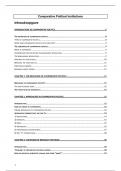Summary
Complete summary Comparative Political Institutions (1200PSWCOP)
- Course
- Institution
- Book
Complete summary of all Comparative political institutions lessons taught by Davide Vittori. The summary includes information from the powerpoints, own notes from the lesson & the important chapters from Daniele Caramani's book Comparative Politics (6th edition). Complete summary of all lessons...
[Show more]




